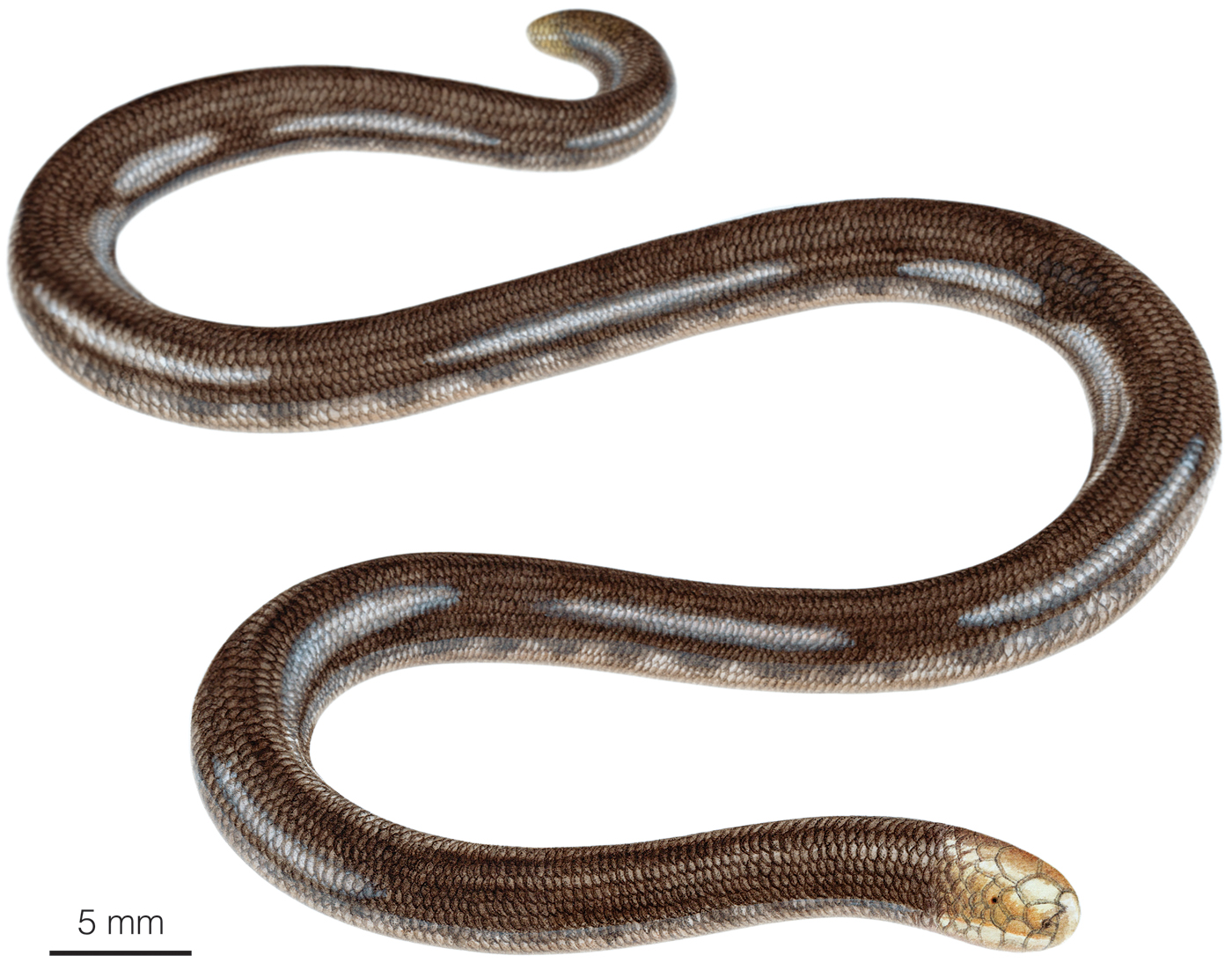Published February 4, 2024. Open access. | Purchase book ❯ |
Yellow-headed Blind-Snake (Anomalepis flavapices)
Reptiles of Ecuador | Serpentes | Anomalepididae | Anomalepis flavapices
English common names: Yellow-headed Blind-Snake, Ecuador Blind-Snake.
Spanish common names: Culebra ciega cabeciamarilla, serpiente ciega delgada.
Recognition: 14.6 cm.1,2 Anomalepis flavapices is a dwarf, archaic looking snake characterized by having eyes that are extremely small, rudimentary, and concealed under a scale, and by having ventral scales similar in size to dorsals.1,3 This species differs from all other blind snakes occurring in western Ecuador by having a pair of polygonal prefrontal scales in contact behind the rostral, followed by a pentagonal frontal.3 Unlike Epictia subcrotilla, this species lacks a yellow spot on the head and on the tail-tip.2 The upper body exhibits a dark brown hue which contrasts sharply with the light brown ventral surfaces. Notably, the head and tail-tip lack any brown pigmentation and instead exhibit a yellowish-white shade (Fig. 1).2

Figure 1: Illustration of an adult individual of Anomalepis flavapices based on photographs of the holotype.
Natural history: Anomalepis flavapices is an extremely rare fossorial snake that inhabits areas of rainforest and seasonally dry forest.1,2 Nothing is known about the ecology of this species, but Anomalepis snakes in general have been found buried in soft soil, leaf-litter, or under logs or fallen trees.4 They are oviparous and feed on insects.5,6
Conservation: Data Deficient There is inadequate information to make an assessment of extinction risk..7 Anomalepis flavapices is included in this category because there is inadequate information to make an assessment of its extinction risk based on its scarce distribution data. The species is only known from two localities (Fig. 2) in areas experiencing markedly different rainforest regimes, suggesting this snake might occur over a wider area. Anomalepis flavapices was last seen in 1907, with no additional sightings despite more than 100 years of herpetological explorations in both Esmeraldas and Manabí provinces. The forest cover between the two localities has been entirely destroyed with the exception of Mache Chindul Ecological Reserve.
Distribution: Anomalepis flavapices is endemic to the Pacific lowlands of Ecuador. It is known from only two localities: the city Esmeraldas and Cerro Jaboncillo (Fig. 2).

Figure 2: Distribution of Anomalepis flavapices in Ecuador. See Appendix 1 for a complete list of the presence localities included in the map.
Etymology: The generic name Anomalepis is derived from the Greek words anomalos (=abnormal) and lepis (=scale),8 and refers to the abnormal head scales. The specific epithet flavapices is derived from the Latin flavus (=yellow) and apices (=tips), and refers to the yellow head and tail-tip.2
See it in the wild: The Yellow-headed Blind-Snake was last seen alive in 1907, suggesting the species is either extinct, not valid to begin with, or just extremely rare. The two Ecuadorian anomalepids are undoubtedly the rarest snakes in the country, with no more than two observations each. Although recent attempts to find Anomalepis flavapices have failed, it is possible that an expedition to the still-forested Cerro Jaboncillo could result in the rediscovery of the species.
Author: Alejandro ArteagaaAffiliation: Fundación Khamai, Reserva Arlequín, Ecoruta Paseo del Quinde km 56, Santa Rosa de Mindo, Pichincha 171202, Ecuador.
Illustrator: Valentina Nieto Fernández
How to cite? Arteaga A (2024) Yellow-headed Blind-Snake (Anomalepis flavapices). In: Arteaga A, Bustamante L, Vieira J (Eds) Reptiles of Ecuador: Life in the middle of the world. Available from: www.reptilesofecuador.com. DOI: 10.47051/ZSJF1865
Literature cited:
- Kofron C (1988) The central and south-american blindsnakes of the genus Anomalepis. Amphibia-Reptilia 9: 7–14.
- Peters JA (1957) Taxonomic notes on Ecuadorian snakes in the American Museum of Natural History. American Museum Novitates 1851: 1–13.
- Peters JA, Orejas-Miranda B (1970) Catalogue of Neotropical Squamata: part I, snakes. Bulletin of the United States National Museum, Washington, D.C., 347 pp.
- Lamar Stickel A, Abarca JG, Pounds JA (2017) Anomalepis mexicanus (Mexican Blind Snake): geographic distribution. Herpetological Review 48: 589.
- Leenders T (2019) Reptiles of Costa Rica: a field guide. Cornell University Press, Ithaca, 625 pp.
- Savage JM (2002) The amphibians and reptiles of Costa Rica, a herpetofauna between two continents, between two seas. The University of Chicago Press, Chicago, 934 pp.
- Cisneros-Heredia DF (2016) Anomalepis flavapices. The IUCN Red List of threatened species. Available from: www.iucnredlist.org. DOI: 10.2305/IUCN.UK.2016-1.RLTS.T203192A2761868.en
- Brown RW (1956) Composition of scientific words. Smithsonian Books, Washington D.C., 882 pp.
Appendix 1: Locality data used to create the distribution map of Anomalepis flavapices in Ecuador (Fig. 2). Go to the section on symbols and abbreviations for a list of acronyms used.
| Country | Province | Locality | Source |
| Ecuador | Esmeraldas | Esmeraldas* | Peters 1957 |
| Ecuador | Manabí | Cerro Jaboncillo | Peters 1957 |